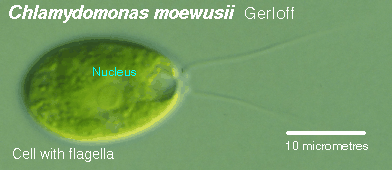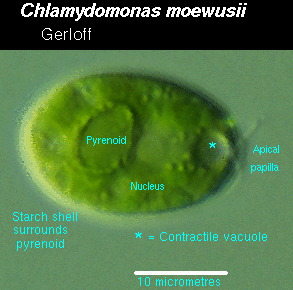
The following descriptions apply to cells as found in nature, or to wild-type cells in optimal culture conditions. Wild-type cells under stress, or mutant cell lines, may appear very different.
Chlamydomonas cells usually are encountered either as thin-walled vegetative cells or thick-walled cysts. The cells are solitary or aggregated into randomly-organized "palmelloid" colonies; algae with any nonrandom colonial organization at any stage in the life history belong to other genera.

The vegetative cells range from 5 to perhaps 100 micrometers in length, and may be elliptical, egg-shaped, or nearly spherical in outline. Individual species have characteristic shapes and size ranges within these limits.

Swimming cells have two flagella inserted into a minute papilla at the anterior end of the cell; cells with other than two flagella, or without the papilla, belong to other genera. A thin cell wall is present; naked cells belong to other genera, as do those with thick walls or loricas. A single nucleus is present, usually just beneath the basal bodies. Most of the cell volume is occupied by one or more grass-green chloroplasts. In the most familiar species, one cup-shaped chloroplast is present, but in other species the chloroplast may be reticulate, stellate or any of a variety of other shapes. One or more pyrenoids are present within the chloroplast(s); starch grains surround the pyrenoid(s). Some species may accumulate reddish secondary carotenoids when grown under nutrient (especially nitrogen) limited conditions.
Some Chlamydomonas species, especially those adapted to soil or subaerial (e.g. on rocks nearwaterfalls, or on plant parts in moist forests) habitats, form "palmelloid" colonies in which the cells lose their flagella and secrete copious amounts of mucilage. Cell structure in these colonies, except for the absence of flagella, differs little from free-swimming cells.
Cysts are generally spherical and have thick walls with or without extensive surface ornamentation. Cysts commonly are reddish due to the accumulation of secondary carotenoids and low chlorophyll content.
Return to summary information